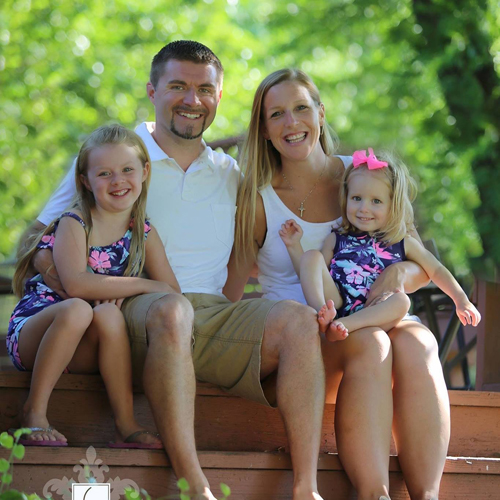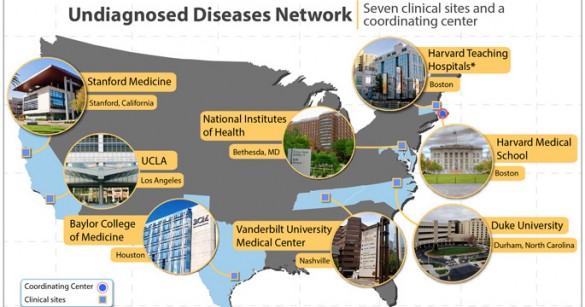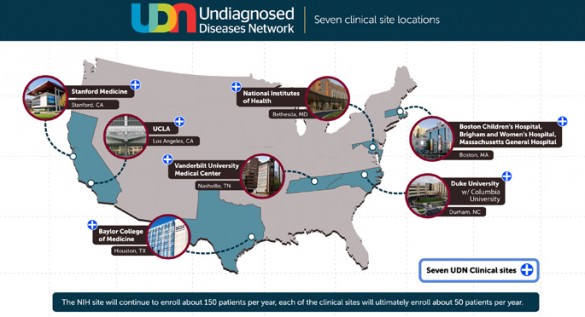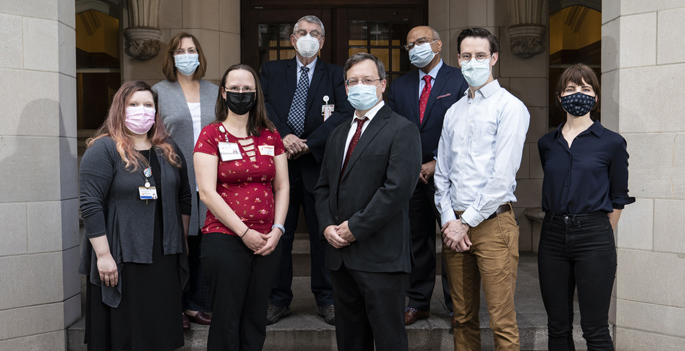On July 6, 2017, the Krauter family of Hiawatha, Kansas, received a belated 4th birthday present for their younger daughter, Mady — a diagnosis for a host of worsening neurological symptoms that they first noticed when she was 3 months old.
The official diagnosis — the UBA5 gene mutation — came from Vanderbilt’s Undiagnosed Diseases Network (UDN) clinical site, one of 12 sites of a clinical research initiative of the National Institutes of Health (NIH).

Through funding from the NIH Common Fund, the 12 sites and four core labs work together to try to solve medical mysteries through team science. The network’s purpose is to bring together clinical and research experts from across the United States to solve the most challenging medical mysteries using advanced technologies.
An undiagnosed disease can be a new disease or a rare presentation of a rare disease. Patients who apply to the UDN sites and are routed to one of the 12 sites have not been diagnosed — not because they don’t have something — but because nobody has seen it before.
Mady, now 5, was the first person in the United States diagnosed with the UBA5 gene mutation and the eighth in the world. Her mother, Kim, with Mady in her lap, spoke by Skype to the board of Monroe Carell Jr. Children’s Hospital at Vanderbilt last week.
Kim said she and her husband, Brent, were relieved to have a diagnosis, but said it’s just the first piece of a complicated puzzle. Next on their agenda: creating a social network of parents who have children diagnosed with the UBA5 gene mutation and raising money for research that could ultimately find a treatment or cure for the degenerative disease.
“It took four long years (for a diagnosis),” Kim said. “I went to Vanderbilt thinking ‘finally I’m getting some answers.’ We got a diagnosis and it’s great to have a name, but I left with so many questions. ‘Is my daughter going to walk? Is she going to talk to me? What will her life look like from here on out?’”
Kim said that a search for Mady’s diagnosis began when she was about 6 months old. Mady cried for hours a day and her parents noticed that she had an eye that “wandered.” She wasn’t gaining weight, her muscles were contracting, and they took her first to her pediatrician, then an ophthalmologist and a neurologist. After MRI and CT scans, metabolic testing and extensive genetic testing, they still had no answers.
“All of the tests came back what we called ‘frustratingly normal,’ meaning while we didn’t want anything to be wrong, we knew that something was going on and nothing was giving us any answers,” Kim said.
That’s when their neurologist suggested they apply to the UDN. “Vanderbilt was the best experience we ever had at a hospital,” Kim told the board last week. “Everyone there was wonderful.”
Over the past four years, the Vanderbilt UDN site has been responsible for about 25 percent of all diagnoses made by the original seven sites named in 2014.
Families who are searching for a diagnosis can spend hundreds of thousands of dollars for medical testing and travel, said Rizwan Hamid, MD, PhD, chief of Genetic Medicine and Genomic Medicine, Dorothy O. Wells Professor of Pediatrics and Cancer Biology and one of the site’s four principal investigators, along with John Phillips III, MD, professor of Pediatrics, Biochemistry and Medicine and the David T. Karzon Professor of Pediatrics; John Newman, MD, the Elsa S. Hanigan Professor of Pulmonary Medicine; and Joy Cogan, PhD, professor of Pediatrics.
“They go through a lot of anguish and even if they find a diagnosis, it can sometimes take decades. They are medical refugees battling an unknown enemy,” Hamid told the Children’s Hospital Board, saying that he hopes to soon be able to help more patients.
“We don’t want to limit ourselves to 30 patients a year through the UDN. We want to be able to help every patient who comes to us with a rare and undiagnosed disease.”
Kim said they were originally supposed to meet with the UDN team at Vanderbilt for several days, but after forwarding the whole exome and genome genetic testing that had already been done elsewhere, someone from Vanderbilt’s UDN team called her back and told her they’d need to see them just for a day.
“I was really confused. I thought we’d be there for a while. My heart fell. I thought they were going to tell me there was nothing they could do for us, but they said, ‘something showed up in her genetic testing and we think we know what it is.’”
After Mady’s diagnosis, Kim dove into finding out what she could about the UBA5 gene mutation. There has only been one study, and the children in that study “didn’t look like Mady,” she said.
“Most of them had seizures. Mady never had a seizure (but has begun having them since). Most had feeding tubes. She’s never had one. It’s a degenerative disorder, but that’s not what I was seeing in Mady,” she said, adding that “there’s a wide spectrum” in how children are affected by the mutation.
“We call Mady ‘the unicorn of the UBA5 gene mutation,’ because if you look at the details of this degenerative disorder, she should not be doing some of the things she’s doing. “Cognitively she knows her numbers, letters and colors. She can do some sign language. She knows how to get her needs met by vocalizing. She just doesn’t say words.”
The one consistency is that none of the children can walk or talk and all hit their developmental milestones very late. Most don’t sit up until they’re about 3.
Since starting the Facebook page, “Life with the UBA5 Gene Mutation,” she has found 22 children who have been diagnosed, one of them in Kansas.
Kim hopes connecting with more children with the mutation will help answer questions for the families who are affected.















